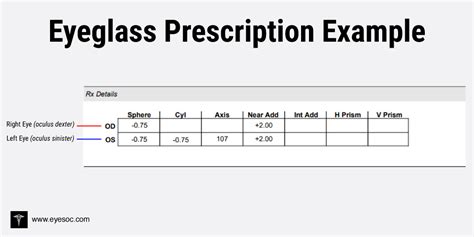How to Read Your Glasses Prescription: A Simple Guide
Understanding your eyeglass prescription can feel like deciphering a secret code, but it doesn't have to be! This guide breaks down the key components, empowering you to confidently navigate your eye care needs. Knowing what your prescription says allows you to compare prices, order online, or simply understand your own vision needs better.
Decoding the Numbers and Letters: Understanding Your Prescription
Your prescription is more than just a jumble of numbers; it's a precise blueprint of your vision. Let's explore the common elements:
OD (Oculus Dexter) and OS (Oculus Sinister):
These abbreviations are crucial. OD refers to your right eye, and OS refers to your left eye. You'll find separate entries for each eye.
Sphere (SPH):
This indicates the power of the lens needed to correct your myopia (nearsightedness) or hyperopia (farsightedness).
- A negative number (-) signifies myopia (nearsightedness). The higher the negative number (e.g., -4.00), the stronger the correction needed.
- A positive number (+) signifies hyperopia (farsightedness). The higher the positive number (e.g., +2.00), the stronger the correction needed.
- 0.00 means no correction is needed for this aspect of your vision.
Cylinder (CYL):
This refers to the power needed to correct astigmatism, a condition where the cornea (the front surface of your eye) is not perfectly round, resulting in blurry vision at all distances. A value of 0.00 indicates no astigmatism. The higher the number, the stronger the astigmatism correction needed.
Axis (AXIS):
This number (ranging from 1 to 180) indicates the orientation of the astigmatism. It specifies the direction of the lens's power correction. It's always paired with the Cylinder value.
Add:
This is often found in prescriptions for reading glasses or bifocals. It represents the additional power added to the distance prescription to aid in near vision. This is crucial if you're needing correction for both near and farsightedness.
Prism:
This section may or may not be present. Prism corrects for eye muscle imbalances. It's less common but important if prescribed.
Example Prescription Breakdown:
Let's look at a sample:
OD: SPH -1.00 CYL -0.50 AXIS 180 OS: SPH -0.75 CYL 0.00 AXIS 000
This prescription shows:
- Right Eye (OD): Nearsightedness (-1.00) with mild astigmatism (-0.50 at axis 180).
- Left Eye (OS): Mild nearsightedness (-0.75) with no astigmatism.
What to Do With Your Prescription:
- Visit an Optician: While you can now understand the basics, always consult a qualified optician or ophthalmologist for advice on selecting the right frames and lenses for your needs. They can also offer adjustments for things like pupil distance which your prescription doesn't include.
- Online Ordering: Some online retailers allow you to input your prescription, but always double-check the accuracy of your data before proceeding.
- Comparing Prices: Understanding your prescription allows you to compare prices from different providers more efficiently.
Beyond the Numbers: Your Vision Health
Remember, your prescription is a snapshot of your vision at a specific time. Regular eye exams are vital to monitor changes and ensure your glasses continue to provide optimal vision correction.
This guide provides a foundational understanding of your glasses prescription. Always consult with your eye care professional for personalized advice. Remember, clear vision is crucial for your overall well-being!
